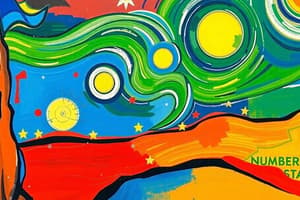Podcast
Questions and Answers
Which book format combines text and illustration, allowing the text to stand alone while the illustrations complement it?
Which book format combines text and illustration, allowing the text to stand alone while the illustrations complement it?
- Illustrated Books (correct)
- Graphic Novels
- Chapter Books
- Picture Books
What type of picture book is characterized by having no text at all?
What type of picture book is characterized by having no text at all?
- Graphic Novels
- Board Books
- Picture Storybooks
- Textless Picture Books (correct)
Which format is specifically designed for visual learners and tells a complete story in a comic book style?
Which format is specifically designed for visual learners and tells a complete story in a comic book style?
- Chapter Books
- Graphic Novels (correct)
- Picture Storybooks
- Illustrated Books
What differentiates chapter books from picture books?
What differentiates chapter books from picture books?
During which historical period did the Classical type of children's literature, such as Aesop's Fables, emerge?
During which historical period did the Classical type of children's literature, such as Aesop's Fables, emerge?
Which statement correctly describes picture storybooks?
Which statement correctly describes picture storybooks?
What distinguishes illustrated books from graphic novels?
What distinguishes illustrated books from graphic novels?
Which book format typically includes board books and pop-up books?
Which book format typically includes board books and pop-up books?
What is a verse novel?
What is a verse novel?
Which of the following statements about storytelling in ancient Greece and Rome is true?
Which of the following statements about storytelling in ancient Greece and Rome is true?
What role did the Roman Catholic Church play during the Middle Ages?
What role did the Roman Catholic Church play during the Middle Ages?
What was a significant impact of Gutenberg's invention of the printing press?
What was a significant impact of Gutenberg's invention of the printing press?
How did Puritanism influence literature and education in North America?
How did Puritanism influence literature and education in North America?
What concept did John Locke introduce regarding children’s minds?
What concept did John Locke introduce regarding children’s minds?
Which literary work is considered one of the first children's picture books?
Which literary work is considered one of the first children's picture books?
Which of the following statements about modern retellings of ancient tales is accurate?
Which of the following statements about modern retellings of ancient tales is accurate?
Flashcards are hidden until you start studying
Study Notes
Group Overview
- Leader: Donna Mae Javier
- Members: Rhyzel Ann Lawas, Jagreel Evangelista, Irene Centeno
History Background of Children’s Literature
- Classical Period: Featured works like Aesop’s Fables, which laid the foundation for children's storytelling.
- Medieval Period: Marked by oral storytelling, largely influenced by the Roman Catholic Church, including tales of saints and heroes like King Arthur and Beowulf.
- Renaissance Period: Initiated a revival of classical ideals; the printing press (circa 1450) made books accessible, enhancing education.
- 18th Century: Shifted focus towards children's education and morality through literature.
- 20th Century: Saw diversification in styles and themes in children's literature.
- Edwardian Era: Reflected social changes and increasingly included children’s perspectives in narratives.
Book Formats for Children and Adolescent Literature
-
Picture Books:
- Illustrated with minimal text, emphasizing colorful images.
- Includes textless or wordless variants.
- Types:
- Picture storybooks: Illustrations crucial for narrative development.
- Pop-up/Board books: Interactive formats allowing children to manipulate the text and illustrations.
-
Illustrated Books:
- Text and illustrations are combined, but text can stand on its own.
- Features fewer illustrations than picture books, complementing the written narrative.
-
Graphic Novels:
- Developed by Will Eisner; blends comic book style with a singular, cohesive story.
- Designed for visual learners appreciating illustrated narratives.
-
Chapter Books:
- Longer texts with complex narratives, featuring little to no illustrations.
- Can be fictional or non-fictional in nature.
-
Verse Novels:
- Written in poetic form, telling a lengthy narrative through a series of poems.
- Each poem captures significant moments in a character’s life.
Themes in Historical Children’s Literature
-
The Classical World:
- Storytelling aimed at educating and entertaining, preserving cultural legacy.
- Key works include Homer’s "Iliad" and "Odyssey," and Virgil’s "Aeneid."
- Modern authors like Padraic Colum adapt ancient tales, affirming their educational value.
-
The Middle Ages:
- Transition to oral narratives, often centered around the Church and moral tales.
- Prominent stories include biblical narratives and epic legends recited by bards.
- Modern adaptations continue to enrich cultural literacy.
-
The Renaissance World:
- Marked a resurgence of classical thought, with significant advances in printing technology.
- Early children’s literature served educational needs, focusing on morality and behavior.
- Noteworthy work: John Comenius’s "Orbis Sensualium Pictus," the first picture book influencing educational practices.
-
Puritanism:
- Advocated for literacy and education in North America, focusing on biblical reading.
- Founded institutions like Harvard College, although many viewed secular literature as trivial.
-
John Locke’s Educational Philosophy:
- Introduced the concept of "tabula rasa," emphasizing the impact of environment over heredity on a child's development.
- Advocated for equal learning potential, influencing perceptions of education for children.
-
Bunyan, Defoe, and Swift:
- Early 18th-century authors contributing to the evolution of children’s literature.
Studying That Suits You
Use AI to generate personalized quizzes and flashcards to suit your learning preferences.



